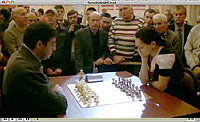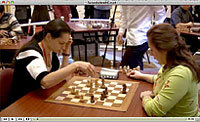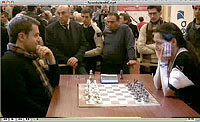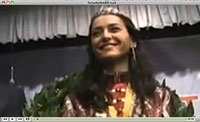Huge Chess Set Collection Auction by Christie's in London
Chess blog for latest chess news and chess trivia (c) Alexandra Kosteniuk, 2013
Hi everyone,
From Alexandra Kosteniuk's
www.chessblog.com
Also see her personal blog at
www.chessqueen.com
Don't miss Chess Queen™
YouTube Channel

Hi everyone,
An 18th century German chess set made from amber, a material favoured for its translucent beauty (estimate: £10,000-15,000, lot 490). Photo: Christie's Images Ltd 2013.
LONDON.- Christie’s will offer chess enthusiasts, collectors and players the opportunity to bid on an unusually large array of chess sets from a European Collection in the Style & Spirit auction on 26 March 2013. As international attention turns to London for The World Chess Candidates Tournament (14 March – 2 April), the 58 chess sets featured celebrate the history of the game and the skill of 18th century to 21st century carvers and craftsmen from around the globe: from Europe, Russia and India, to Cambodia and China. Executed in a wide variety of materials, including ivory, bone, wood, amber and silver, the sets have estimates ranging from £300 to £25,000. Presenting rare and beautiful examples which will enrich existing collections and potentially inspire new ones to be formed, this collection is sure to appeal to all tastes and budgets. A highlight of the sale is a limited edition silver chess set by Man Ray, one of the leading artists of the Dada and Surrealist movements during the 20th century (estimate: £10,000-15,000). One of ten sets made in 2008, the design was originally conceived in 1920 when Man Ray prepared drawings for a chess set in the Dada tradition of taking an object and presenting it in a different form, ultimately creating ‘a symbolic evocation’. For example, Man Ray takes inspiration from the broken neck of a violin for the knight; a pyramid - a symbol of Egyptian Kingship - for the King; and the conical shape - suggestive of a lady’s headdress in mediaeval times - for the Queen. In 1945 Man Ray was given the opportunity to realise these designs, when he was invited to participate in a group exhibition entitled The Imagery of Chess, by Julian Levy. With Man Ray’s photographic portraits currently on exhibition at the National Portrait Gallery, this chess set provides additional insight into the variety of his oeuvre. The most valuable set in the collection is an intricate Anglo-Indian ivory chess set, carved in Berhampur near Calcutta in the first half of the 19th century (estimate: £15,000-25,000). This area became renowned for its superior quality of carving when Berhampur was established as a British barrack town in 1765, after the Battle of Plassey. The settlement created a demand for skilled craftsmen to produce export goods, encouraging many talented ivory carvers from Delhi to migrate south. The present example exemplifies the refined skill of these craftsmen.
Further examples on offer:
• A French carved ivory bust type chess set. The kings and queens represent the Turkish Ottomans versus the European monarchs, highlighting French colonial interests in North Africa in the 19th century (estimate: £6,000-10,000, lot 481). • A Russian Walrus Ivory chess set, likely made by Kholmogory carvers in the late 18th century depicting the Turks versus the Romans (estimate: £10,000-15,000, lot 488). • An 18th century German chess set made from amber, a material favoured for its translucent beauty (estimate: £10,000-15,000, lot 490). • A Chinese-export ‘puzzle-ball’ figural chess set of large proportions, 19th century, with the kings and queens representing Imperial Emperors and Empresses, bishops as mandarins, the knights on horseback, the rooks elephants and the pawns as warriors on horseback (estimate: £8,000-12,000, lot 526). • A Cambodian ivory chess set of abstract form, 19th century (estimate: £4,000-6,000, lot 521). • An Indian gilt-heightened polychrome ivory figural chess set, late 19th century, the kings and queens modelled as elephants carrying seated princes in howdahs, the bishops as camels, the knights as horsemen, the rooks as elephants and the pawns as foot soldiers (estimate: £7,000-10,000, lot 502). Chess is a game of great antiquity and while its precise origins are obscure, it seems probable that it was originally an Indian invention. During the 6th century it was evidently part of Persian custom and culture, from where it was adopted by the occupying Arab armies in the 7th century. The game was carried westwards with the expanding Arab Muslim Empire during the following centuries, reaching across Spain and into Southern Italy. The Hamburger Schachklub is the oldest and largest chess club in Germany, established in 1830. The appeal of chess games transcends chess players and aficionados to include those who are captivated by the character and workmanship of the pieces. Many sets are highly regarded as miniature works of art in an interior setting, and are also viewed as providing the perfect executive conversation piece. (- Artdaily.org)
From Alexandra Kosteniuk's
www.chessblog.com
Also see her personal blog at
www.chessqueen.com
Don't miss Chess Queen™
YouTube Channel

Labels: chess auction, Christies chess, london chess



































0 Comments:
Post a Comment
Note: Only a member of this blog may post a comment.
Subscribe to Post Comments [Atom]
<< Home